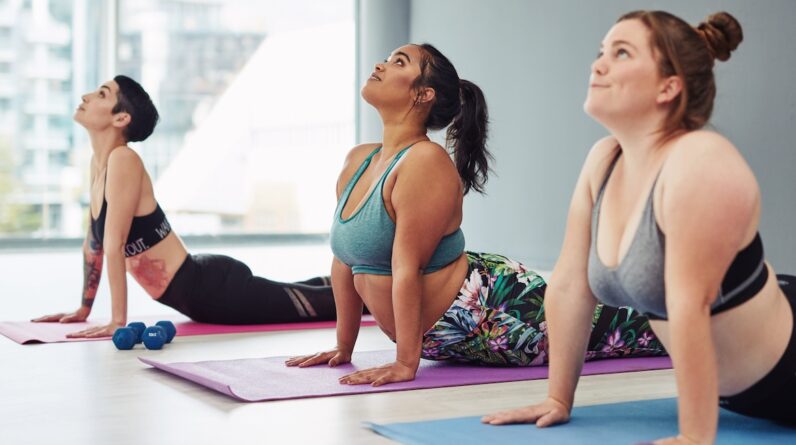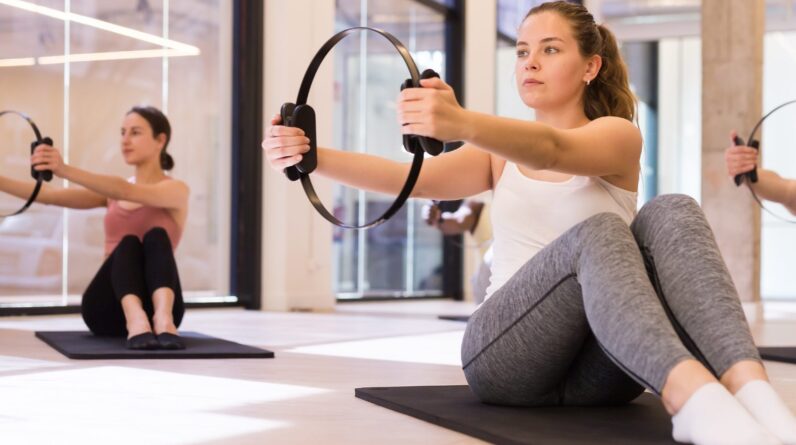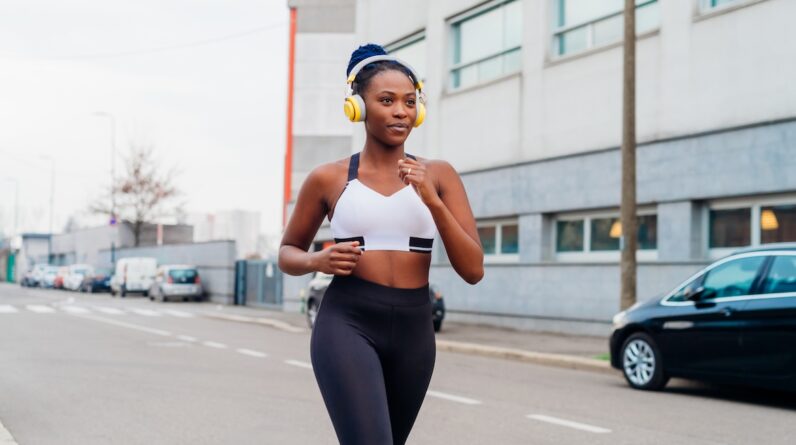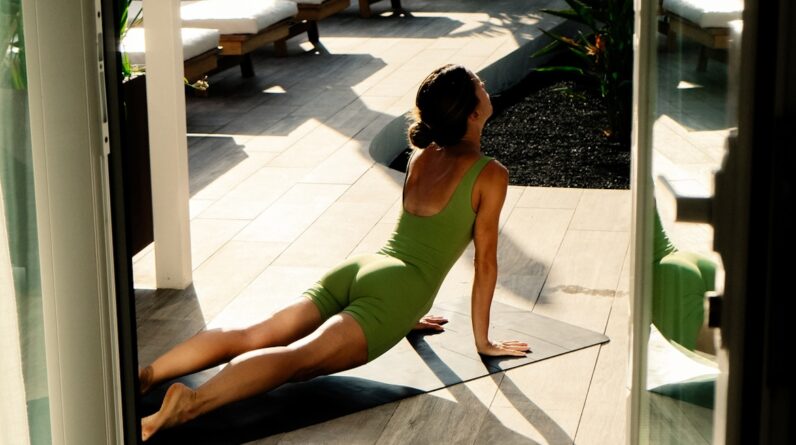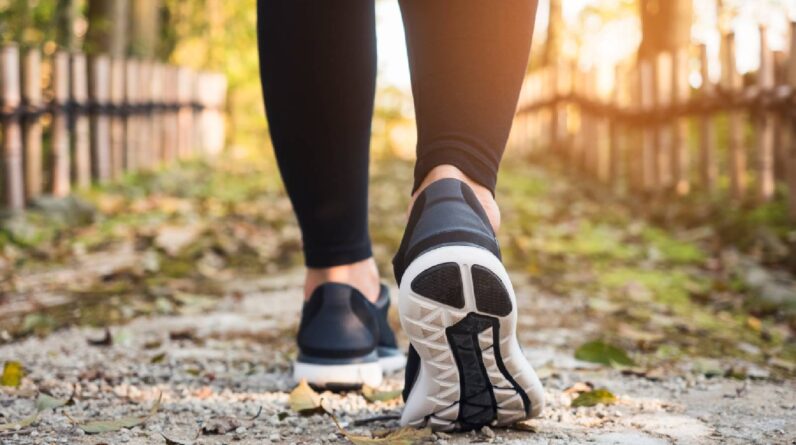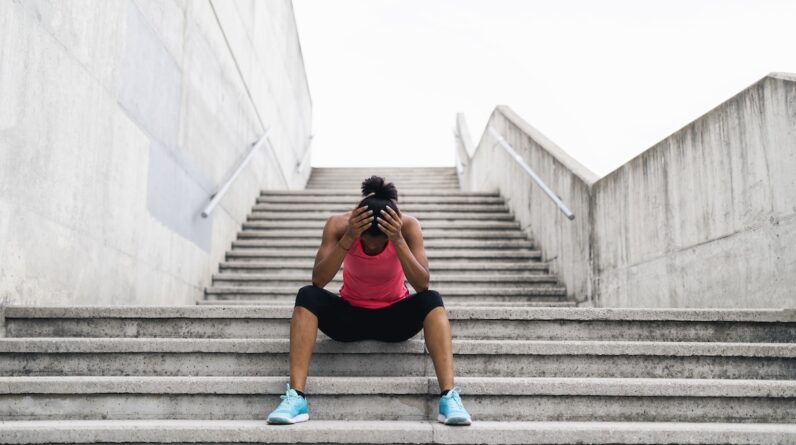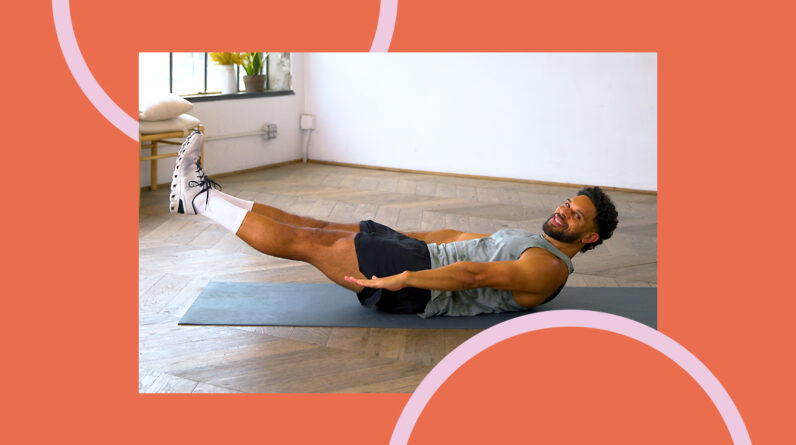
Traditionally used as a warm-up exercise, the move is “primarily a breathing exercise meant to strengthen and challenge breath capacity, control, and endurance,” says Cassandra Cotta, a certified Pilates instructor and founder of Pilates People in New York City.
But this full-body, zero-equipment exercise will also strengthen your core, legs, and arms, all while improving posture and spinal stability. Oh, and it’s cardio, too.
Here’s how to nail this two-minute, core-igniting exercise in your next Pilates session.
How to do the Pilates hundred with perfect form every time
- Lie flat on your back with knees bent and feet flat together on the floor.
- Extend your arms up to the ceiling at shoulder height with your palms facing down.
- Keeping your legs glued together, use your core to lift your legs into a tabletop position, with your feet off the mat, knees over ankles, and ankles in line with knees at a 90-degree angle.
- Curl your head, neck, and chest up into a “crunch” position while reaching your arms toward your legs and extending your legs long on a diagonal line, about 45 degrees. If your lower back feels strained, Cotta recommends lifting your legs a little higher, bringing them back to a tabletop position, or lowering them to the floor.
- Keeping your wrists and fingers straight, start pumping the arms up and down in rapid, short movements while inhaling for five counts and exhaling for five counts.
- Repeat the breath pattern ten times to reach 100.
- Bend your knees back into a tabletop position as you rest your head, neck, and shoulders back on the floor. Or hug your knees into your chest for a restorative stretch.
Which muscles does the Pilates hundred work?
While the Pilates hundred usually kicks off a session, you can do it as a stand-alone core exercise.
The movement targets several muscles in your midsection, including your transverse abdominis, rectus abdominis, and internal and external obliques, according to Cotta. The arm pumps work your triceps, while the extended leg position fires up your inner thighs, quadriceps, hip flexors, and glutes.
“All those movements put together makes this a cardiovascular exercise, one of very few in the traditional Pilates canon,” Cotta says.
The biggest benefits of the Pilates hundred
There’s a reason this core-burning exercise is a staple in all types of Pilates classes.
1. It increases core strength
“A weak core puts pressure on the spine, which can lead to poor posture and lower back pain,” says Kali Arnold, MD, a certified Pilates instructor and owner of Sati Yoga & Wellness in Atlanta.
By targeting and strengthening deep abdominal muscles, the Pilates hundred builds core strength that’ll reduce stress on your joints, ligaments, and tendons during daily movements, helping to prevent injuries.
2. It improves spinal alignment and posture
Did you sit up straighter while reading this? Yes, there’s hope even for chronic slouchers. The hundred reverses the impact of the dreaded “tech neck,” tension and discomfort from your shoulders and upper body rounding forward over screens.
The move “increases the strength of the abdominal and back muscles, creating a strong internal corset to protect the spine and improve alignment,” Dr. Arnold says. The result? Better posture, even after you step off the mat.
3. It enhances breath control.
Whether due to stress, anxiety, or sheer business, most of us aren’t aware of our breathing during the day. The Pilates hundred’s specific breathing pattern “oxygenates the tissues and improves breath control, which calms the nervous system and decreases stress,” Dr. Arnold says.
That breath control will also translate to better performance and control during other physical activities, like running and lifting weights.
“When it comes to the Pilates hundred, no pain is a good thing and actually means more gains.” —Cassandra Cotta, certified Pilates instructor
Variations to make the Pilates hundred more accessible—or more challenging
While lifting your head off the mat and extending your legs to a 45-degree angle is the most traditional version of this movement, here are a few variations that offer the same core burn.
1. Pilates hundred with head down
If your neck feels strained in the classical position, lower it to the mat. You can also add a towel or blanket behind your head for extra comfort and support.
- Lie flat on your back with your knees bent and feet flat pressing flat into the mat. Leave your head down or place a towel or blanket under your neck for support.
- Extend your arms up to the ceiling at shoulder height with your palms facing down.
- Keeping your legs glued together, use your core to lift your legs into a tabletop position, or 90-degree angle.
- With straight arms, reach toward your legs while extending your legs out to 45 degrees.
- Vigorously pump your arms up and down while inhaling for five counts and exhaling for five counts.
- Repeat ten times to reach 100.
- Bend your knees back into the tabletop and rest.
2. Pilates hundred with feet on floor
Dr. Arnold recommends this variation for people with lower back issues or tight hip flexors.
- Lie flat on your back with your knees bent, pressing your feet firmly into the ground.
- Extend your arms up to the ceiling at shoulder height with your palms facing down.
- Lift your head, neck, and chest off the floor while reaching your straight arms to the opposite side of the room.
- With straight arms and wrists, pump your arms up and down as you inhale for five counts and exhale for five counts.
- Repeat ten times to reach 100.
- Lower your head to the mat and rest.
3. Pilates hundred with a prop
Want to up the intensity? Place a small Pilates ball or ring between your ankles, which “engages the adductor muscles of the inner thighs and the deep pelvic floor muscles,” Dr. Arnold says. You can also hold small weights or Pilates fitness balls in each hand to add an upper-body challenge.
- Lie flat on your back with your knees bent, pressing your feet firmly into the ground.
- With your palms facing down and weights in hand, extend your arms up to the ceiling at shoulder height.
- Use your core to lift your head, neck, and chest off the floor while reaching your straight arms to the opposite side of the room.
- Extend your legs up to the ceiling, then lower to 45 degrees, squeezing the prop equally with both sides.
- With straight arms and wrists, pump your arms up and down as you inhale for five counts and exhale for five counts. Fire up your legs and core by pulsing the prop with each beat.
- Repeat ten times to reach 100.
- Lower your head and legs back to the mat with control.
4. Pilates hundred with legs lowered
The lower your legs are, the more of a burn you’ll feel in your core, Cotta says. But be careful not to go so low that your lower back strains or arches off the mat.
- Lie flat on your back with your knees bent and feet flat on the floor.
- With your palms facing down, extend your arms up to the ceiling at shoulder height.
- Use your core to lift your head, neck, and chest off the floor while reaching your straight arms to the opposite side of the room.
- Extend your legs up to the ceiling, then lower as far as possible without arching your lower back.
- With straight arms and wrists, pump your arms up and down as you inhale for five counts and exhale for five counts.
- Repeat ten times to reach 100.
- Lower your head and legs back to the starting position and rest.
Common mistakes to avoid
Between pumping your arms, lifting your head, and cued breathing, the Pilates hundred is an intense and complicated move— even for people who have a ton of Pilates experience.
Dr. Arnold says some people experience neck strain during the exercise, from alignment or not properly activating their abdominals. If that’s you, she recommends lifting your shoulder blades off the mat and tucking your chin slightly toward your chest to take the pressure off your neck while firing up your core. If your neck still feels strained, opt to keep your head down or supported by a towel or other prop.
The move’s precise breathing technique can also trip up newbies—especially while pumping your arms and holding up your legs and head.
“Some people new to the exercise will take in a short breath, hold it, then quickly exhale,” Dr. Arnold says. “Try to remember to inhale over five full counts and exhale over five full counts, as the breath pattern is vital for oxygenating the tissues and engaging the transversus abdominis.”
And while it won’t cause pain, Cotta says flapping your arms with bent elbows or wrists takes away some of the exercise’s intensity, so remember to straighten your arms from your shoulder blades to the tips of your fingers to get the most bang for your buck.
Safety tips to keep in mind
As with any exercise, if you feel pain or strain while doing the Pilates hundred, it’s important to back off the intensity or modify the movement.
“If your back hurts, it probably means your legs are too low in the extension and your lumbar spine is coming away from the floor,” Cotta says. Her easy fix: moving your legs into a more supportive position, such as a tabletop or on the floor.
You can also avoid neck strain by making sure your chin is in toward your chest rather than facing the ceiling or resting your head on the mat or on a prop.
However, the most comfortable position varies from person to person, so it’s best to pick the variation that works best for you, Cotta says.
“When it comes to the Pilates hundred, no pain is a good thing and actually means more gains,” she says.






